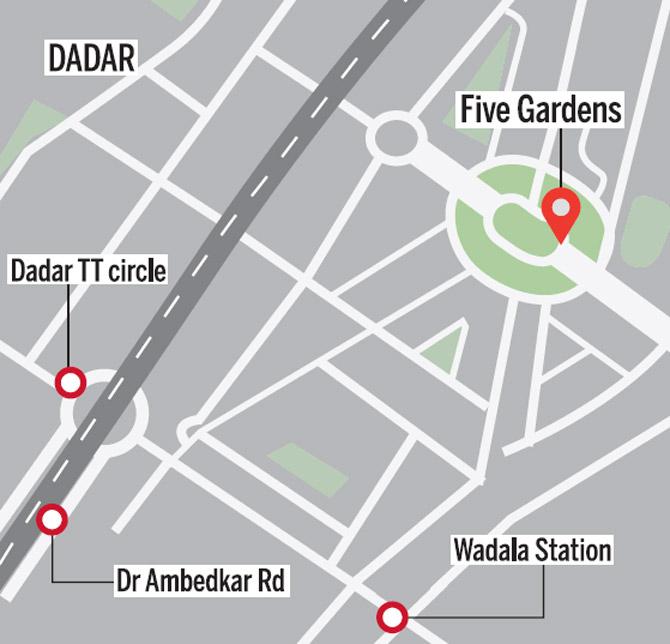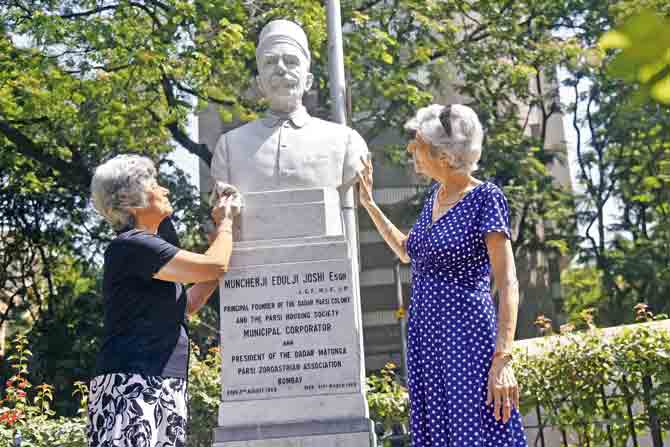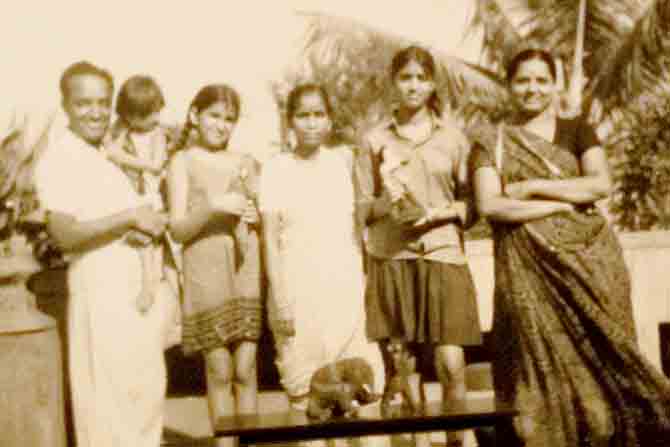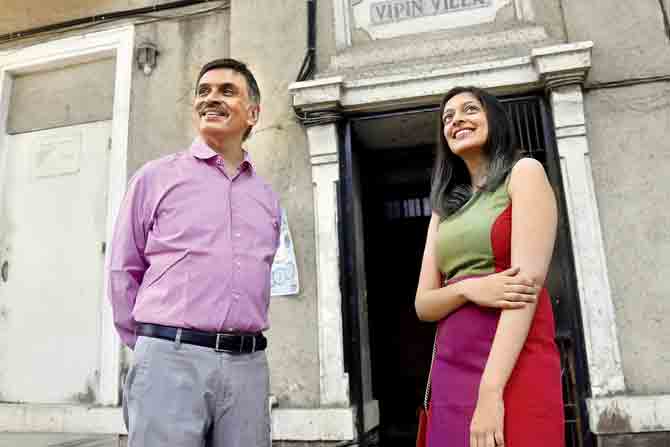A green lung of the city, the Five Gardens vicinity of Dadar Parsi Colony, in its centenary year, is more of a cosmopolitan haven than you think

Colony girl's Ratna Pathak Shah revels in revisiting her childhood home, Laxmi Sadan. Pic/ Ashish Raje

The balconies wink softly in the changed light of approaching sunset. There is something indescribably special gazing at the spot where you wailed your way into the world over a half-century ago. Then, Narvekar Nursing Home on Jame Jamshed Road was Mulla Nursing Home. Skipping traffic signals to deliver tots on time, gynaecologist Tehmi Mulla would plead with protesting policemen, "Sorry, can babies wait?"
My brother and I were Bandra-bred but Dadar-born to parents who met at Perviz Hall, the Dadar Parsi Colony (DPC) social hub. Dad wooed and won Mum with a lecture series on Western Classical music. Wistfully, I imagine how countless couples must have dated at what is now basically a food outlet, announcing: "Original Parsi delicacies, redefined".
Down the quiet cool of two arterial lanes is the memorial bust of philanthropist Mancherji Joshi, my mother's granduncle. His death anniversary fell last week in this centenary year of the colony he founded—the world's largest ungated Zoroastrian enclave, inhabited by every fourth community member (approximately 10,000 of Bombay's 42,000 Parsis and Iranis).
ADVERTISEMENT
 Illustration/ Uday Mohite
Illustration/ Uday Mohite
"Mental space stands in direct proportion to our perception of the physical," believes neurosurgeon and fellow Sunday mid-day columnist Dr Mazda Turel. "Driving through Ambedkar Road's insane traffic, the moment I make a sweet right turn into Dadar Parsi Colony, I'm transformed. This is Bombay's Amazon forest. Crazy main street honking is silenced by the chirping of birds and whistling of rain trees." On an arboreal path facing the impeccably maintained Panchgani Garden, he reaches Turel Terrace, bought by his grandfather in the early 1970s. "A joy we cherish daily, spaces like this have emotional and spiritual effects on our well-being."
Before telling me how Panchgani Garden earned the name, Zareen Engineer and her sister Sooni Davar relate the story of their grandfather's exceptional vision in raising the colony. A civil engineer with the Bombay Improvement Trust, Mancherji Joshi dreamt of accommodating middle class Parsis on marshland the British developed under the 1899-1900 Dadar-Matunga-Wadala-Sion Scheme. "Bhejoo khasee gayooch ke, have you lost your head?" exploded the first few women to husbands bringing them to such soggy, seemingly inhospitable acres.
Rant became rave witnessing the resultant construction focused on properly regulated sanitation systems in structures no higher than three storeys at least 15 feet apart. Woven within a mesh of residential and institutional buildings like Sohrab Palamkote Hall, on beautifully laid streets, manicured lawn expanses were interspersed with multicultural, educational and socio- religious centres like the Dadar Athornan Institute—a boarding madrassa training Parsi priests—and Rustam Faram Agiary. In the gardens' circular heart tinkled a coloured water fountain. Around it, orchestral ensembles struck up at the bandstand picturesquely naming buildings like Band View.

Zareen Engineer and Sooni Davar, granddaughters of Mancherji Joshi, at the commemorative marble bust marking the entrance to the colony he founded a century ago. Pic/ Pradeep Dhivar
"That the colony functions as one big family is hardly cliché. Fourteen gardens and 12 citizens' bodies make us unique," says Zareen in a chintzy apartment with sweeping park vistas. A vocal force of MEJCRA, Mancherji Edalji Joshi Colony Residents Association, like her illustrious ancestor (begged daylong to fix problems from menacing monkeys to piling garbage), Zareen tries ensuring the colony remains as pristine as possible. The Panchgani Garden was christened because boys played hockey on this ground during holidays from Panchgani boarding school. The girls' hockey team was known as the Panchgani Pansies.
The stateliest old-timers of Five Gardens, of course, are ancient trees fringing parks and avenues. Mapping them in her little gem, Trees of Dadar Parsi Colony, naturalist resident Katie Bagli indexes 60 verdant varieties, from African tulip tree to White silk cotton tree, with interesting explanations. Casuarina derives from the Latinised version of the Australian cassowary, its droopy branches resembling the bird's plumage. The Guest Tree's species, "hospita", owes to Dutch botanist Kleinhoff freely distributing these saplings.

Ratna (second from left) after a doll-making class at Balodyan, the culture club pioneered by Vipin Gandhi (extreme left), her actress mother Dina Pathak's brother
"How many vicinities have gardens built into their design? I was also very proud of the exquisite buildings surrounding me in DPC," says Ratna Pathak Shah who enjoyed a childhood in and around the strikingly Art Deco Laxmi Sadan, next to Dadar Parsi Gymkhana. She laughs recollecting zealously guarded "railing gangs"— clusters of Parsi and non-Parsi girls and boys huddled for idle chatter or serious romance, sitting on metal railings that ringed the gardens. "It was as liberating to see the sexes mix freely as it was to hear unusual cusswords. Swearing in front of families was new for us, amused listening to 'MC-BC' type of phrases."
Schooling in the colony, too, Ratna admits Parsis rubbed off on her to a remarkable extent. "Ours is anyway the generation that got the best of modern India and I can't imagine spending those fantastic formative years elsewhere. Significantly different from a parochial look at life, the Parsi influence was a release from Gujarati, South Indian and Maharashtrian conservatism. The colony anchored us interactively. It was distinctly Parsi in mood, yet never exclusively so. How deep our relationships went, sharing ideas, discussing life."

Dental surgeon Sanjeev Gandhi with his psychotherapist daughter Rhea outside Vipin Villa, named after Sanjeev's father
An enriching connect was Balodyan, the children's centre her uncle Vipin Gandhi started in the late 1950s. A dentist by profession, his cultural inclination was of a piece with his accomplished sisters, Shanta, Tarla and Ratna's mother, veteran actress-activist Dina Pathak. Besides thriving science and movie clubs, a library with rare titles like one on Australian aborigine art Ratna remembers, Balodyan enlisted parents and teachers to teach sports, craft and cooking. They organised food and game melas, and directed plays marking the theatrical foray of talents like Ratna. Balodyan's monthly programme and notices were cyclostyled on the blank side of pages from issues of Soviet Land, a paper published in 13 languages, which her mother worked with.
"The DPC heritage is precious and lasting," says Dr Sanjeev Gandhi, the son of Vipin Gandhi. Near impossible to stroll through Five Gardens for just a minute uninterrupted by patients and pals greeting him, not forgetting a warm exchange with the old kacchi kairi seller from schooldays. Progressing to serene paths I rambled through on vacation with my grandparents, we set off from Vipin Villa, acquired in the 1940s by Sanjeev's PWD engineer grandfather, Kalidas Gandhi. Today, the dental clinic of her grandfather and father is the well-appointed workspace of Sanjeev's psychotherapist daug-hter Rhea.

Two trees flowering in Bombay only within the Five Gardens-Parsi Colony precinct. The Hatiamuki, with white blooms and long stamens, is of Madagascar origin. The Trincomali, with heart-shaped leaves, has a species nomenclature, Cordifolia, from “cor” meaning heart and “folium”, leaf. Pics courtesy/ Katie Bagli/ Trees of Dadr Parsi colony
I gather charming fluffs of trivia treading on local history. Sixty summers back it was Lakhan Golawala's stall at Five Gardens that introduced Bombay to the tart kaala khatta flavour. The recreation park equipment boasted a pure iron jungle gym and marble slide. Where the banyan tree spreads, a reservoir being built offered kids exciting passage hideouts.
"What is lovely is that Five Gardens isn't an oppressive stretch for women to walk on," observes Sameera Khan, co-author of Why Loiter? Women and Risk on Mumbai Streets. "People lounge in the floodlit maidan eating roadside anda-pav and noodles, many hostel students from VJTI or ICT. The corner open-air gymnasium is packed with men exercising at midnight, the maidan centre sees friends and families, including older women, play badminton. Young breakdancers practise on top of a water tanki. I've stood watching at 11 pm on a Friday, feeling elated we have such spaces for rest, sport and recreation even late at night. Some Sundays, men in white with Nehru topis, representing different rural Maharashtrian groups, congregate in the gardens to discuss their village matters in the city." Living near DPC, Sameera's daughters attended JB Vachha School, learnt karate at Jehangir Shroff's dojo, ballet from Villoo Bharucha, piano lessons with
Pervin Damania—Five Gardens legends all.

Vrinda Nabar, Mumbai University'sformer Head of Department, English Literature, as a laughing toddler (extreme right) with her siblings in the early 1950s on the verandah of Rustom Mansion
"This is a familiar stomping ground which was flamboyant and safe, its trees bordering wide roads on which we learned to cycle and a park around every corner," says Dr Vrinda Nabar, Mumbai University's former Head of Department, English Lit, whose MA classes I loved years ago. Presently a regular visiting professor at Northwestern University, Illinois, she grew up in Rustom Mansion opposite the Customs Quarters.
"Five Gardens is happening and laidback, an ambience we struggle to retain despite the marauding tenacity of real estate developers. Our building was a microcosm of the city's pluralism, with the landlord Parsi, neighbours Catholic, Gujarati, Parsi, Bengali and even an Englishman who stayed back post 1947. Not far was 'Hollywood Lane', where the Kapoors were, the 'bhoot bangla' singer Saigal was said to have lived at, and Asha Puthli, already iconic to our youthful minds. We sat recognising notables like 'Octopus Iyengar', rumoured to have lost an arm battling an octopus in the Juhu Beach waters!"
Trailing about further, winding in and out of leafy lanes, I'm reminded of architect Kamu Iyer write in Boombay: From Precincts to Sprawl—"This colony's exclusivity is imperceptible, as homes and the space outside merge inseparably into the city fabric, unlike other gated communities like lone objects in the landscape. Most buildings in Parsi Colony were built by architects. In Hindu Colony they were commissioned to contractors."
Turel concludes, "This place fuels energy. You think better, are calmer, age slower. According to neuroscience, more novel solutions to creative problems are generated from home than in any other environment. And if home is DPC, you're at an unfair advantage."
Author-publisher Meher Marfatia writes fortnightly on everything that makes her love Mumbai and adore Bombay. Reach her at meher.marfatia@mid-day.com/www.mehermarfatia.com
Catch up on all the latest Mumbai news, crime news, current affairs, and also a complete guide on Mumbai from food to things to do and events across the city here. Also download the new mid-day Android and iOS apps to get latest updates
 Subscribe today by clicking the link and stay updated with the latest news!" Click here!
Subscribe today by clicking the link and stay updated with the latest news!" Click here!







